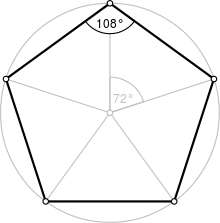Pentagons
| Regular pentagon | |
|---|---|

A regular pentagon
|
|
| Type | Regular polygon |
| Edges and vertices | 5 |
| Schläfli symbol | {5} |
| Coxeter diagram | |
| Symmetry group | Dihedral (D5), order 2×5 |
| Internal angle (degrees) | 108° |
| Dual polygon | Self |
| Properties | Convex, cyclic, equilateral, isogonal, isotoxal |
In geometry, a pentagon (from the Greek πέντε pente and γωνία gonia, meaning five and angle) is any five-sided polygon or 5-gon. The sum of the internal angles in a simple pentagon is 540°.
A pentagon may be simple or self-intersecting. A self-intersecting regular pentagon (or star pentagon) is called a pentagram.
A regular pentagon has Schläfli symbol {5} and interior angles are 108°.
A regular pentagon has five lines of reflectional symmetry, and rotational symmetry of order 5 (through 72°, 144°, 216° and 288°). The diagonals of a convex regular pentagon are in the golden ratio to its sides. Its height (distance from one side to the opposite vertex) and width (distance between two farthest separated points, which equals the diagonal length) are given by
where R is the radius of the circumcircle.
The area of a convex regular convex pentagon with side length t is given by
A pentagram or pentangle is a regular star pentagon. Its Schläfli symbol is {5/2}. Its sides form the diagonals of a regular convex pentagon – in this arrangement the sides of the two pentagons are in the golden ratio.
...
Wikipedia
